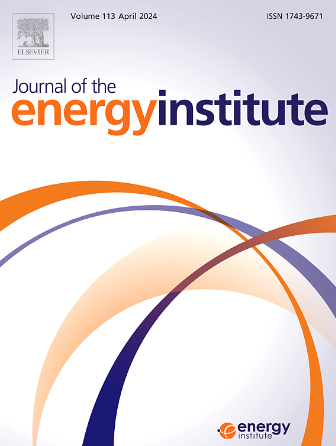ni基烃类催化水热液化城市污水污泥所得生物原油的表征
IF 6.2
2区 工程技术
Q2 ENERGY & FUELS
引用次数: 0
摘要
水热液化(HTL)技术处理城市污水污泥(简称污泥)是提高污泥中有机物含量的有效方法。然而,挑战依然存在,特别是在优化生物原油产量和过程中的副产品管理方面。本文以污泥HTL固相产物煅烧后的产物氢炭(HC)为载体负载NiO制备催化剂,并将NiO/HC催化剂用于污泥水热液化工艺。对催化剂的性能进行了评价。通过改变水热液化反应温度、次数、催化剂负载量等关键反应参数,系统研究了NiO/HC催化剂对污泥水热液化的催化模式。固相产物在煅烧过程中,部分晶体沿特定方向生长,形成具有粗糙表面气孔的纤维状结构,增加了与反应物的接触面积,因此负载NiO可以增加表面活性位点。NiO颗粒在HC表面均匀分布,并表现出一定的聚集特征。生物原油产量随反应温度和反应时间的增加而大幅度增加,随催化剂负荷的减少而增加。在350℃、60 min、5 wt%催化剂条件下,生物原油收率最高,达17.93 wt%。在325℃、20 min、催化剂质量分数为10 wt%的条件下,生物原油质量最高,最高热值(HHV)达到39.40 MJ kg−1,回收率(ER)达到50.91%。与传统催化剂相比,NiO/HC催化剂具有更好的稳定性和可重复使用性。通过调整反应参数,可进一步提高生物原油的收率和质量。为污泥资源化利用提供了理论支持。本文章由计算机程序翻译,如有差异,请以英文原文为准。

Characterization of biocrude oil obtained from the catalytic hydrothermal liquefaction of municipal sewage sludge with a Ni-based hydrochar
The hydrothermal liquefaction (HTL) technology for municipal sewage sludge (referred to as sludge) treatment presents an effective method to improve organic matter content in sludges. However, challenges remain, particularly regarding the optimization of biocrude oil yield and by-product management during the process. In this paper, a catalyst was prepared by loading NiO with hydrochar (HC), a product of calcined HTL solid-phase product of sludge, as a carrier, and the NiO/HC catalyst was used in the hydrothermal liquefaction process of sludge. The performance of the catalyst was evaluated. The catalytic pattern of NiO/HC catalysts for hydrothermal liquefaction of sludge was systematically investigated by varying the key reaction parameters such as hydrothermal liquefaction reaction temperatures, times, and catalyst loadings. During the calcination process of the solid-phase product, some of the crystals grow along a specific direction, forming a fibrous structure with rough surface pores, which increases the contact area with the reactants, so the loaded NiO can increase the active sites on the surface. The NiO particles are uniformly distributed on the HC surface and show certain aggregation characteristics. Biocrude oil overwhelmingly increased with reaction temperature and reaction time increasing, and increased with catalyst loading decreasing. The highest yield of biocrude oil was obtained at 350 °C, 60 min and 5 wt% catalyst, which reached up to 17.93 wt%. The highest quality of biocrude oil was obtained at 325 °C, 20 min, and 10 wt% catalyst, at which time the higher heating value (HHV) reached 39.40 MJ kg−1 and the recovery rate (ER) reached 50.91 %. Compared with conventional catalysts, NiO/HC catalysts exhibit better stability and reusability. By adjusting the reaction parameters, the yield and quality of biocrude oil can be further improved. It provides theoretical support for the resource utilization of sludge.
求助全文
通过发布文献求助,成功后即可免费获取论文全文。
去求助
来源期刊

Journal of The Energy Institute
工程技术-能源与燃料
CiteScore
10.60
自引率
5.30%
发文量
166
审稿时长
16 days
期刊介绍:
The Journal of the Energy Institute provides peer reviewed coverage of original high quality research on energy, engineering and technology.The coverage is broad and the main areas of interest include:
Combustion engineering and associated technologies; process heating; power generation; engines and propulsion; emissions and environmental pollution control; clean coal technologies; carbon abatement technologies
Emissions and environmental pollution control; safety and hazards;
Clean coal technologies; carbon abatement technologies, including carbon capture and storage, CCS;
Petroleum engineering and fuel quality, including storage and transport
Alternative energy sources; biomass utilisation and biomass conversion technologies; energy from waste, incineration and recycling
Energy conversion, energy recovery and energy efficiency; space heating, fuel cells, heat pumps and cooling systems
Energy storage
The journal''s coverage reflects changes in energy technology that result from the transition to more efficient energy production and end use together with reduced carbon emission.
 求助内容:
求助内容: 应助结果提醒方式:
应助结果提醒方式:


